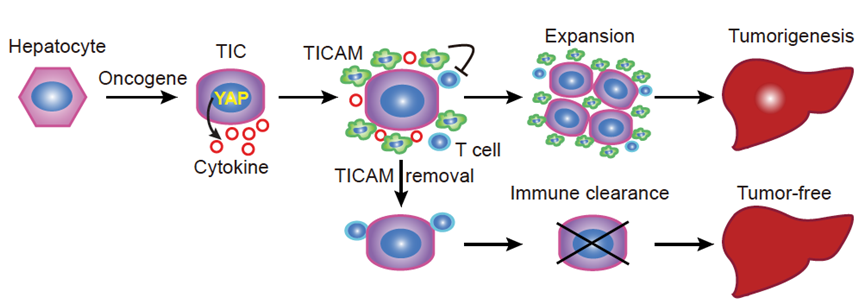Dr. Bin Zhao’s group published a research article on Genes& Development online on February 21, 2017 with the title “Single tumor-initiating cells evade immune clearance by recruiting type II macrophages”. Dr. Bin Zhao is the corresponding author and graduate student XiaocanGuo is the first author.
Tumor cells display extensive and dynamic crosstalk with inflammatory cells in the tumor microenvironment. Macrophages are a major type of immune cells that participate in this tumor-microenvironment interplay. For instance, in tissues with chronic inflammation caused by pathogen infection, smoking, or obesity, macrophages are capable of creating an environment that promotes cellular acquisition of tumorigenic mutational hits. Macrophages involved in these tumor-initiating systematic inflammations are of the immune activated (M1) type and are not specifically associated with tumor cells. Interestingly, established tumors also actively recruit macrophages (tumor-associated macrophages, TAMs) and educate them to be protumorigenic. TAMs adopt a trophic immunosuppressive phenotypethat is functionally reminiscent of the alternatively activated type II (M2) macrophages. TAMs promote tumor progression by facilitating angiogenesis, promoting proliferation and invasion, and suppressing immunosurveillance. It was generally believed that the recruitment of macrophages into established tumors was mediated by factors such as CSF1, VEFGA, and CCL2 secreted from the altered and often hypoxic tumor microenvironment. However, macrophages were also found to enrich in carcinogen diethylnitrosamine(DEN)-induced small foci of altered hepatocytes (FAH) containing tumor-initiating cells (TICs), in which a typical hypoxic tumor microenvironment was absent. This observation suggests that during tumorigenesis, macrophages could be recruited at a much earlier stage. However, due to technical difficulties involved in the tracing and manipulation of individualTICs in vivo, the mechanism of recruitment and the function of these TIC-associated macrophages (TICAMs) have not been determined experimentally.
In this report, by generating genetically defined liver TICs, Dr. Zhao’s group demonstrate that TICs actively recruit M2 macrophages from as early as the single cell stage. Elimination of TIC-associated macrophages (TICAMs) abolishes tumorigenesis in a manner dependent on the immune system. Mechanistically, activation of the Hippo pathway effector YAP is underlying macrophage recruitment by TICs. These results demonstrate for the first time that macrophages play a decisive role in the survival of single TIC in vivo, and provide a proof of principle for TIC elimination by targeting YAP or M2 macrophages.

Full text link:http://genesdev.cshlp.org/content/early/2017/02/21/gad.294348.116.full.pdf+html



